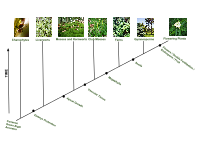
The origin and evolution of the ALOG proteins, members of a plant-specific transcription factor family, in land plants
Sign Up to like & getrecommendations! Published in 2020 at "Journal of Plant Research"
DOI: 10.1007/s10265-020-01171-6
Abstract: The Arabidopsis LSH1 and Oryza G1 (ALOG) protein is a family of plant-specific transcription factors that regulate reproductive growth in angiosperms. Despite their importance in plant development, little research has been conducted on ALOG proteins… read more here.
Keywords: evolution; plant; alog; land plants ... See more keywords

Phototropism in land plants: Molecules and mechanism from light perception to response
Sign Up to like & getrecommendations! Published in 2018 at "Frontiers in Biology"
DOI: 10.1007/s11515-018-1518-y
Abstract: BackgroundPhototropism is the response a plant exhibits when it is faced with a directional blue light stimulus. Though a seemingly simple differential cell elongation response within a responding tissue that results in organ curvature, phototropism… read more here.
Keywords: response; land plants; perception; phototropism ... See more keywords

The Chara Genome: Secondary Complexity and Implications for Plant Terrestrialization
Sign Up to like & getrecommendations! Published in 2018 at "Cell"
DOI: 10.1016/j.cell.2018.06.033
Abstract: Land plants evolved from charophytic algae, among which Charophyceae possess the most complex body plans. We present the genome of Chara braunii; comparison of the genome to those of land plants identified evolutionary novelties for… read more here.
Keywords: plant; complexity; land plants; land ... See more keywords

Archaea, tiny helpers of land plants
Sign Up to like & getrecommendations! Published in 2020 at "Computational and Structural Biotechnology Journal"
DOI: 10.1016/j.csbj.2020.09.005
Abstract: Archaea are members of most microbiomes. While archaea are highly abundant in extreme environments, they are less abundant and diverse in association with eukaryotic hosts. Nevertheless, archaea are a substantial constituent of plant-associated ecosystems in… read more here.
Keywords: tiny helpers; plant; land plants; archaea tiny ... See more keywords

Plant Evolution: Phylogenetic Relationships between the Earliest Land Plants
Sign Up to like & getrecommendations! Published in 2018 at "Current Biology"
DOI: 10.1016/j.cub.2018.01.034
Abstract: The key structures and functions of land plants are most often studied in flowering plant models. However, the evolution of these traits (character states) is often difficult to infer, because we lack an accurate phylogenetic… read more here.
Keywords: land plants; plant evolution; evolution phylogenetic; earliest land ... See more keywords

Evolution: Heterochromatin Diversity in Early-Branching Land Plants
Sign Up to like & getrecommendations! Published in 2020 at "Current Biology"
DOI: 10.1016/j.cub.2019.12.044
Abstract: Chromatin profiling of a liverwort genome reveals an epigenomic landscape where the major mark of developmental silencing in later-branching land plants and in animals also targets subsets of transposons in this early-branching land plant lineage. read more here.
Keywords: branching land; land plants; evolution heterochromatin; heterochromatin diversity ... See more keywords

Oxygenation history of the Neoproterozoic to early Phanerozoic and the rise of land plants
Sign Up to like & getrecommendations! Published in 2017 at "Earth and Planetary Science Letters"
DOI: 10.1016/j.epsl.2017.02.046
Abstract: There has been extensive debate about the history of Earth's oxygenation and the role that land plant evolution played in shaping Earth's ocean–atmosphere system. Here we use the rare earth element patterns in marine carbonates… read more here.
Keywords: oxygenation; land plants; history; earth ... See more keywords

Genome-wide identification and analysis of MICU genes in land plants and their potential role in calcium stress.
Sign Up to like & getrecommendations! Published in 2018 at "Gene"
DOI: 10.1016/j.gene.2018.05.102
Abstract: Mitochondrial calcium uptake (MICU) plays a vital role in the regulation of mitochondrial calcium homeostasis, and, consequently, influences calcium signaling transduction. Although genes involved in mitochondrial calcium uptake have been well studied in animals, less… read more here.
Keywords: analysis; land plants; micu; role ... See more keywords

Bacterial efflux inhibitors are widely distributed in land plants.
Sign Up to like & getrecommendations! Published in 2020 at "Journal of ethnopharmacology"
DOI: 10.1016/j.jep.2020.113533
Abstract: ETHNOPHARMACOLOGICAL RELEVANCE Secondary metabolites play a critical role in plant defense against disease and are of great importance to ethnomedicine. Bacterial efflux pumps are active transport proteins that bacterial cells use to protect themselves against… read more here.
Keywords: staphylococcus aureus; plant; efflux pump; land plants ... See more keywords

Phylogenomics reveals convergent evolution of red-violet coloration in land plants and the origins of the anthocyanin biosynthetic pathway.
Sign Up to like & getrecommendations! Published in 2020 at "Molecular phylogenetics and evolution"
DOI: 10.1016/j.ympev.2020.106904
Abstract: The flavonoids, one of the largest classes of plant secondary metabolites, are found in lineages that span the land plant phylogeny and play important roles in stress responses and as pigments. Perhaps the most well-studied… read more here.
Keywords: evolution; land plants; land; red violet ... See more keywords

A phenol-enriched cuticle is ancestral to lignin evolution in land plants
Sign Up to like & getrecommendations! Published in 2017 at "Nature Communications"
DOI: 10.1038/ncomms14713
Abstract: Lignin, one of the most abundant biopolymers on Earth, derives from the plant phenolic metabolism. It appeared upon terrestrialization and is thought critical for plant colonization of land. Early diverging land plants do not form… read more here.
Keywords: phenol enriched; enriched cuticle; lignin; land plants ... See more keywords